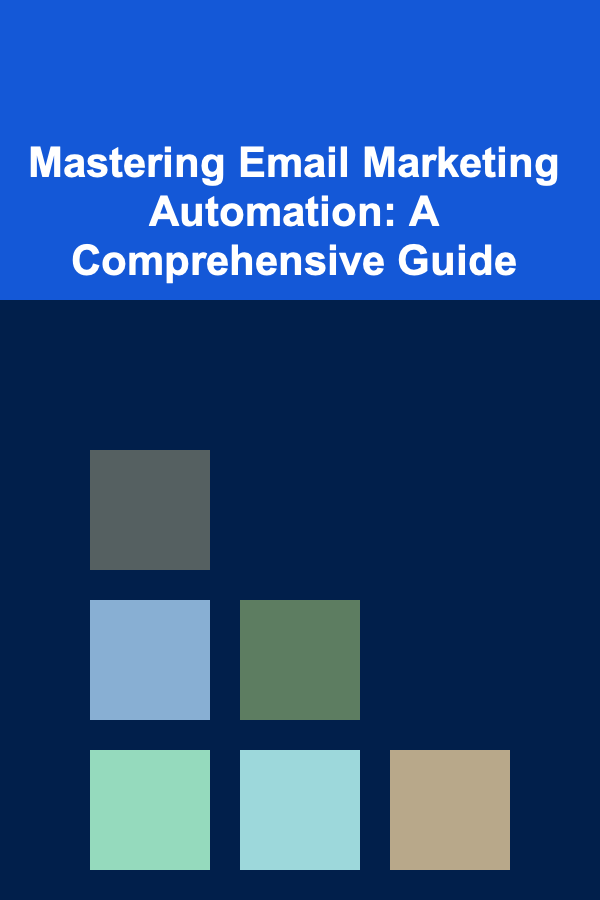
Mastering Email Marketing Automation: A Comprehensive Guide
ebook include PDF & Audio bundle (Micro Guide)
$12.99$6.99
Limited Time Offer! Order within the next:

Email marketing automation is no longer a luxury; it's a necessity for businesses looking to scale, nurture leads, and build lasting customer relationships. In today's competitive digital landscape, manually sending emails is simply unsustainable. This in-depth guide will explore the intricacies of email marketing automation, providing you with actionable strategies, best practices, and advanced techniques to transform your email campaigns from a time-consuming task into a powerful, revenue-generating engine.
Understanding the Fundamentals of Email Marketing Automation
Before diving into the technical aspects, it's crucial to grasp the core principles that underpin effective email marketing automation. It's not just about setting up a sequence of emails and letting it run. It's about understanding your audience, their needs, and how your product or service solves their problems. This understanding forms the foundation of your entire automation strategy.
What is Email Marketing Automation?
At its core, email marketing automation is the process of sending targeted email messages to specific individuals automatically, based on predefined triggers and rules. These triggers can range from a user subscribing to a newsletter to making a purchase, abandoning a cart, or reaching a specific milestone in their customer journey. The "automation" part comes from using software platforms that execute these actions without manual intervention.
Think of it as a digital assistant that works tirelessly behind the scenes, engaging with your audience at the right time with the right message, ultimately driving conversions and fostering loyalty.
Why is Email Marketing Automation Important?
The benefits of email marketing automation are multifaceted and far-reaching. Here's a breakdown of why it's so crucial for modern businesses:
- Increased Efficiency: Automating repetitive tasks frees up your marketing team to focus on more strategic initiatives, such as content creation, campaign analysis, and customer segmentation.
- Improved Lead Nurturing: Automated sequences can guide prospects through the sales funnel, providing valuable information and building trust at each stage. This leads to higher conversion rates and more qualified leads.
- Enhanced Personalization: Automation allows you to segment your audience and personalize email content based on their demographics, behavior, and preferences. This leads to higher engagement and a better customer experience.
- Scalability: As your business grows, automation allows you to reach a larger audience without proportionally increasing your workload. It enables you to maintain a consistent level of engagement even as your customer base expands.
- Data-Driven Insights: Automation platforms provide detailed analytics on email performance, allowing you to track key metrics such as open rates, click-through rates, and conversion rates. This data can be used to optimize your campaigns and improve your overall marketing strategy.
- Consistent Brand Messaging: Automation ensures that your brand message is consistent across all touchpoints, reinforcing your brand identity and building trust with your audience.
- Revenue Generation: Ultimately, email marketing automation is a powerful tool for generating revenue. By nurturing leads, driving conversions, and fostering customer loyalty, it can significantly impact your bottom line.
Key Components of Email Marketing Automation
To successfully implement email marketing automation, it's essential to understand its core components:
- Email Marketing Platform (ESP): The foundation of your automation efforts. ESPs like Mailchimp, ActiveCampaign, HubSpot, and Klaviyo provide the tools and infrastructure to create, send, and track email campaigns. Choosing the right ESP is crucial, as different platforms offer varying features and pricing models.
- Segmentation: Dividing your audience into smaller, more targeted groups based on specific criteria. This allows you to personalize your messaging and deliver more relevant content to each segment. Examples include segmenting by demographics, purchase history, website behavior, and engagement level.
- Triggers: The events that initiate an automated email sequence. These can be anything from a user subscribing to a newsletter to abandoning a shopping cart. Common triggers include:
- Welcome Series: Triggered by a new subscriber joining your email list.
- Abandoned Cart Sequence: Triggered when a user adds items to their cart but doesn't complete the purchase.
- Purchase Follow-Up: Triggered after a customer makes a purchase.
- Anniversary Emails: Triggered on a customer's anniversary of joining your email list or making their first purchase.
- Re-engagement Emails: Triggered when a subscriber becomes inactive.
- Workflows: The automated sequences of emails that are triggered by specific events. Workflows can be simple (e.g., a single welcome email) or complex (e.g., a multi-stage lead nurturing sequence).
- Personalization: Tailoring email content to individual recipients based on their data and preferences. This can include using their name, referencing past purchases, or recommending products based on their browsing history.
- Analytics and Reporting: Tracking key metrics such as open rates, click-through rates, and conversion rates to measure the effectiveness of your campaigns and identify areas for improvement.
Developing Your Email Marketing Automation Strategy
A successful email marketing automation strategy requires careful planning and execution. It's not enough to simply set up a few automated emails and hope for the best. You need to define your goals, understand your audience, and create a roadmap for achieving your objectives.
1. Define Your Goals
What do you want to achieve with email marketing automation? Are you looking to generate more leads, increase sales, improve customer retention, or build brand awareness? Your goals will determine the types of automation campaigns you create and the metrics you track.
Here are some examples of specific, measurable, achievable, relevant, and time-bound (SMART) goals:
- Increase lead generation by 20% in the next quarter.
- Increase sales conversion rate from email by 10% in the next month.
- Reduce customer churn rate by 5% in the next year.
- Improve customer satisfaction score (CSAT) by 15% in the next six months.
2. Understand Your Audience
Knowing your audience is paramount. Who are they? What are their needs, pain points, and aspirations? What motivates them to buy? The more you understand your audience, the better you can tailor your email content and automation workflows to their specific needs.
Consider creating buyer personas to represent your ideal customers. These personas should include details such as demographics, interests, motivations, and online behavior. Use data from your CRM, website analytics, and social media to inform your buyer personas.
3. Map the Customer Journey
The customer journey is the path that a customer takes from initial awareness of your brand to becoming a loyal customer. Understanding the customer journey is crucial for creating effective email marketing automation campaigns that engage customers at the right time with the right message.
Identify key touchpoints in the customer journey, such as website visits, social media interactions, email sign-ups, and purchases. Then, create automated email sequences that address the needs and concerns of customers at each stage of the journey.
For example, a customer who has just signed up for your email list may receive a welcome series that introduces your brand and its values. A customer who has abandoned a shopping cart may receive an email reminding them of the items they left behind and offering a discount to encourage them to complete the purchase.
4. Choose the Right Email Marketing Platform
Selecting the right email marketing platform is critical for the success of your automation efforts. Different platforms offer varying features, pricing models, and levels of support. Consider your budget, technical expertise, and specific needs when choosing a platform.
Here are some popular email marketing platforms to consider:
- Mailchimp: A popular option for small businesses and beginners, offering a user-friendly interface and a free plan for up to 2,000 subscribers.
- ActiveCampaign: A more advanced platform that offers robust automation features, including segmentation, lead scoring, and CRM integration.
- HubSpot: A comprehensive marketing automation platform that integrates with HubSpot's CRM and other marketing tools.
- Klaviyo: A platform specifically designed for e-commerce businesses, offering advanced segmentation and personalization features.
- GetResponse: An all-in-one marketing platform that offers email marketing, landing pages, webinars, and automation tools.
Consider your budget, the size of your email list, and the complexity of your automation needs when making your decision. Most platforms offer free trials or demos, so you can test them out before committing to a subscription.
5. Design Engaging Email Content
Even the most sophisticated automation workflows will fail if your email content is not engaging and relevant. Your emails should be well-written, visually appealing, and provide value to your subscribers.
Here are some tips for designing engaging email content:
- Write Compelling Subject Lines: Your subject line is the first thing that subscribers see, so it needs to be attention-grabbing and relevant. Use action verbs, create a sense of urgency, and personalize your subject lines whenever possible.
- Personalize Your Emails: Personalization goes beyond simply using the subscriber's name. Tailor your email content to their specific interests, needs, and past behavior.
- Use High-Quality Images and Videos: Visual content can make your emails more engaging and memorable. Use high-quality images and videos that are relevant to your message.
- Keep Your Emails Concise and Easy to Read: People are busy, so get straight to the point. Use short paragraphs, bullet points, and headings to make your emails easy to scan.
- Include a Clear Call to Action: Tell subscribers what you want them to do. Use clear and concise calls to action that encourage them to click through to your website, make a purchase, or take another desired action.
- Ensure Mobile Optimization: Many people read emails on their mobile devices, so make sure your emails are optimized for mobile viewing. Use a responsive design that adapts to different screen sizes.
6. Test and Optimize Your Campaigns
Email marketing automation is an iterative process. You should continuously test and optimize your campaigns to improve their performance.
Here are some common A/B testing experiments you can run:
- Subject Lines: Test different subject lines to see which ones generate the highest open rates.
- Email Content: Test different versions of your email content to see which ones generate the highest click-through rates.
- Calls to Action: Test different calls to action to see which ones generate the most conversions.
- Send Times: Test different send times to see which ones generate the highest engagement.
- Email Design: Test different email designs to see which ones are most visually appealing and effective.
Use the data you collect from your A/B tests to make informed decisions about how to improve your campaigns. Continuously test and optimize your emails to ensure you're getting the best possible results.
Advanced Email Marketing Automation Techniques
Once you've mastered the fundamentals of email marketing automation, you can start exploring more advanced techniques to take your campaigns to the next level.
1. Lead Scoring
Lead scoring is the process of assigning points to leads based on their behavior and engagement with your brand. This allows you to identify the most qualified leads and prioritize your sales efforts.
You can assign points for actions such as:
- Visiting your website
- Downloading a whitepaper
- Attending a webinar
- Opening an email
- Clicking on a link in an email
- Requesting a demo
Leads with higher scores are more likely to be ready to buy, so you should focus your sales efforts on them.
2. Dynamic Content
Dynamic content allows you to personalize email content based on the recipient's data and behavior. This can include using their name, referencing past purchases, or recommending products based on their browsing history.
For example, you can use dynamic content to show different product recommendations to different segments of your audience. Or, you can use dynamic content to show different calls to action based on the recipient's stage in the sales funnel.
3. Behavioral Segmentation
Behavioral segmentation involves segmenting your audience based on their actions and behavior on your website, in your emails, and on social media. This allows you to target your messaging to their specific interests and needs.
For example, you can segment your audience based on:
- The pages they visit on your website
- The products they view
- The emails they open and click on
- The social media posts they engage with
By understanding your audience's behavior, you can create highly targeted email campaigns that resonate with them and drive conversions.
4. Predictive Analytics
Predictive analytics uses data to forecast future customer behavior. This can help you identify potential churn risks, predict future purchases, and personalize your marketing efforts.
For example, you can use predictive analytics to identify customers who are likely to churn and send them targeted emails offering incentives to stay. Or, you can use predictive analytics to recommend products that a customer is likely to buy based on their past purchases and browsing history.
5. Multi-Channel Automation
Email marketing automation is most effective when integrated with other marketing channels, such as social media, SMS, and push notifications. Multi-channel automation allows you to create a seamless customer experience across all touchpoints.
For example, you can use email marketing automation to send a welcome email to new subscribers, then follow up with them on social media. Or, you can use SMS to send appointment reminders or delivery updates to customers who have made a purchase.
Best Practices for Email Marketing Automation
To ensure the success of your email marketing automation efforts, it's essential to follow best practices.
- Obtain Explicit Consent: Always get explicit consent from subscribers before adding them to your email list. This is required by law in many countries and also helps to improve your email deliverability.
- Segment Your Audience: Segment your audience based on demographics, behavior, and preferences to personalize your messaging and improve engagement.
- Personalize Your Emails: Use personalization to make your emails more relevant and engaging.
- Provide Value to Your Subscribers: Your emails should provide value to your subscribers, whether it's informative content, exclusive offers, or helpful tips.
- Keep Your Emails Concise and Easy to Read: Get straight to the point and use short paragraphs, bullet points, and headings to make your emails easy to scan.
- Include a Clear Call to Action: Tell subscribers what you want them to do.
- Test and Optimize Your Campaigns: Continuously test and optimize your campaigns to improve their performance.
- Monitor Your Metrics: Track key metrics such as open rates, click-through rates, and conversion rates to measure the effectiveness of your campaigns.
- Comply with Email Marketing Laws: Be aware of and comply with email marketing laws such as GDPR, CAN-SPAM, and CCPA.
- Maintain a Clean Email List: Regularly remove inactive subscribers and invalid email addresses from your list to improve your email deliverability.
Common Mistakes to Avoid
Even with the best intentions, it's easy to make mistakes when implementing email marketing automation. Here are some common pitfalls to avoid:
- Not Having a Clear Strategy: Starting automation without a well-defined strategy is like driving without a map. Define your goals, target audience, and desired outcomes before launching any campaigns.
- Over-Automating: Automation should enhance, not replace, human interaction. Avoid sending too many emails or making your emails sound robotic.
- Ignoring Segmentation: Sending the same email to everyone on your list is a surefire way to decrease engagement. Segment your audience and tailor your messaging accordingly.
- Poor Email Design: A poorly designed email can damage your brand's reputation. Invest in creating visually appealing and mobile-friendly emails.
- Neglecting to Test: Never launch an automation campaign without thoroughly testing it first. Test different subject lines, content, and calls to action to see what works best.
- Forgetting Compliance: Failing to comply with email marketing laws can result in hefty fines. Always obtain explicit consent and provide an easy way for subscribers to unsubscribe.
- Ignoring Analytics: Not tracking your email metrics is like flying blind. Monitor your open rates, click-through rates, and conversion rates to see what's working and what's not.
Conclusion
Email marketing automation is a powerful tool that can transform your business. By understanding the fundamentals, developing a solid strategy, and implementing best practices, you can leverage automation to generate more leads, increase sales, and build lasting customer relationships.
Remember that email marketing automation is an ongoing process. Continuously test, optimize, and adapt your campaigns to meet the evolving needs of your audience. By staying informed and embracing new technologies, you can stay ahead of the curve and unlock the full potential of email marketing automation.

How to Store Shoes Without Cluttering Your Entryway
Read More
How to Store Winter Gear in an Efficient and Accessible Way
Read More
The Ultimate Guide to Minimizing Food Waste and Reducing Your Environmental Impact
Read More
How to Save Money on Drinks While Traveling
Read More
How To Read Children's Books to Learn a Language
Read More
How to Navigate Climate Anxiety and Eco-Grief
Read MoreOther Products

How to Store Shoes Without Cluttering Your Entryway
Read More
How to Store Winter Gear in an Efficient and Accessible Way
Read More
The Ultimate Guide to Minimizing Food Waste and Reducing Your Environmental Impact
Read More
How to Save Money on Drinks While Traveling
Read More
How To Read Children's Books to Learn a Language
Read More